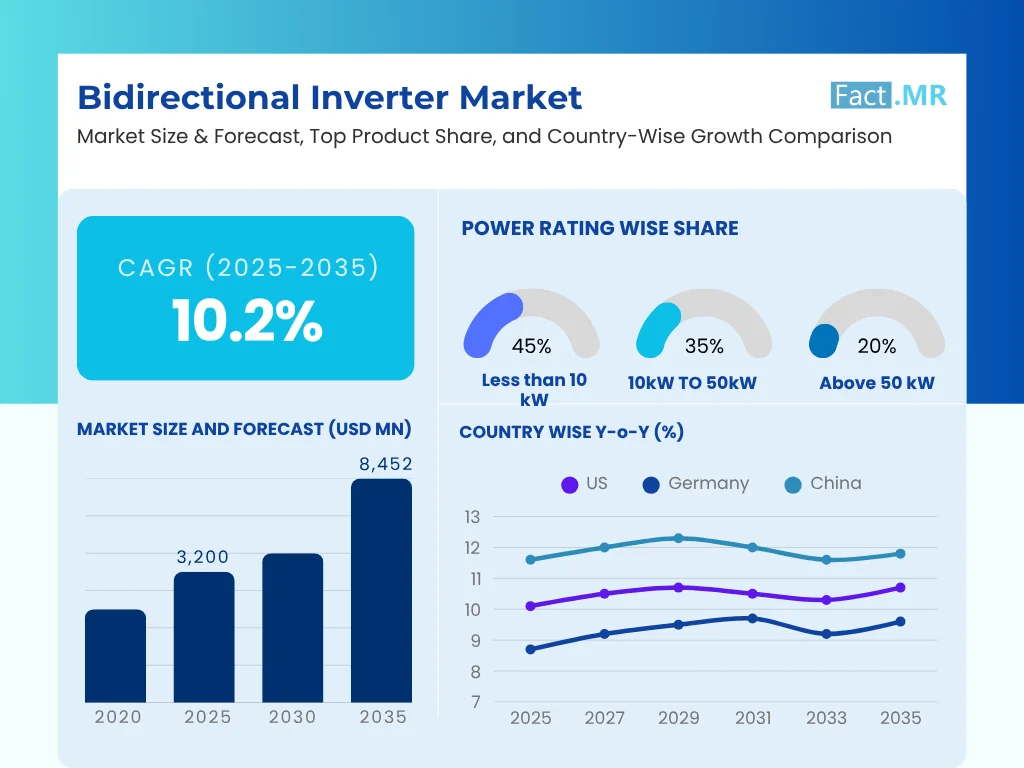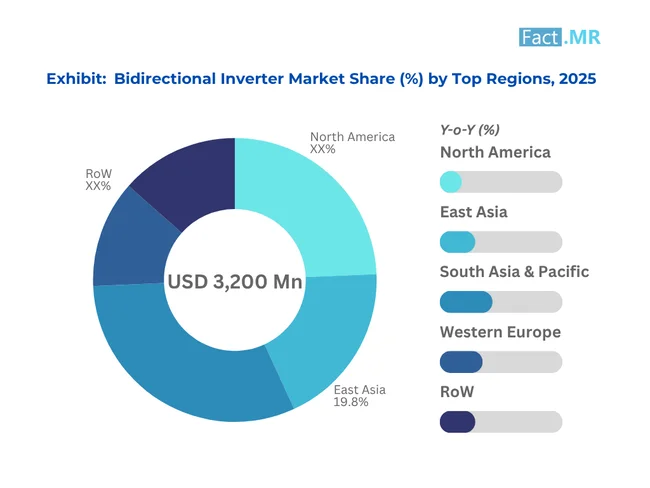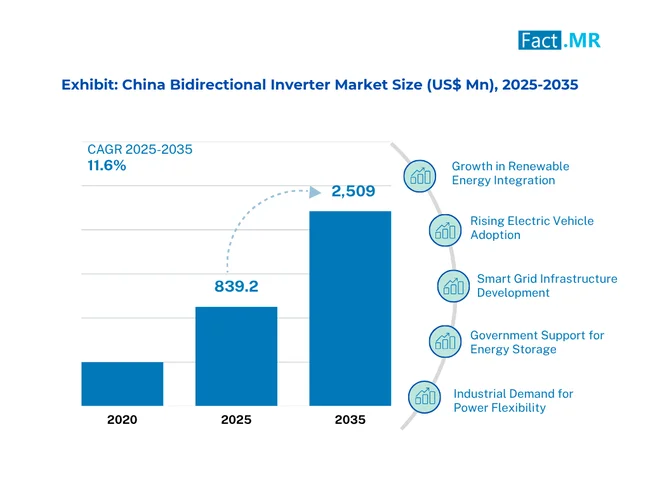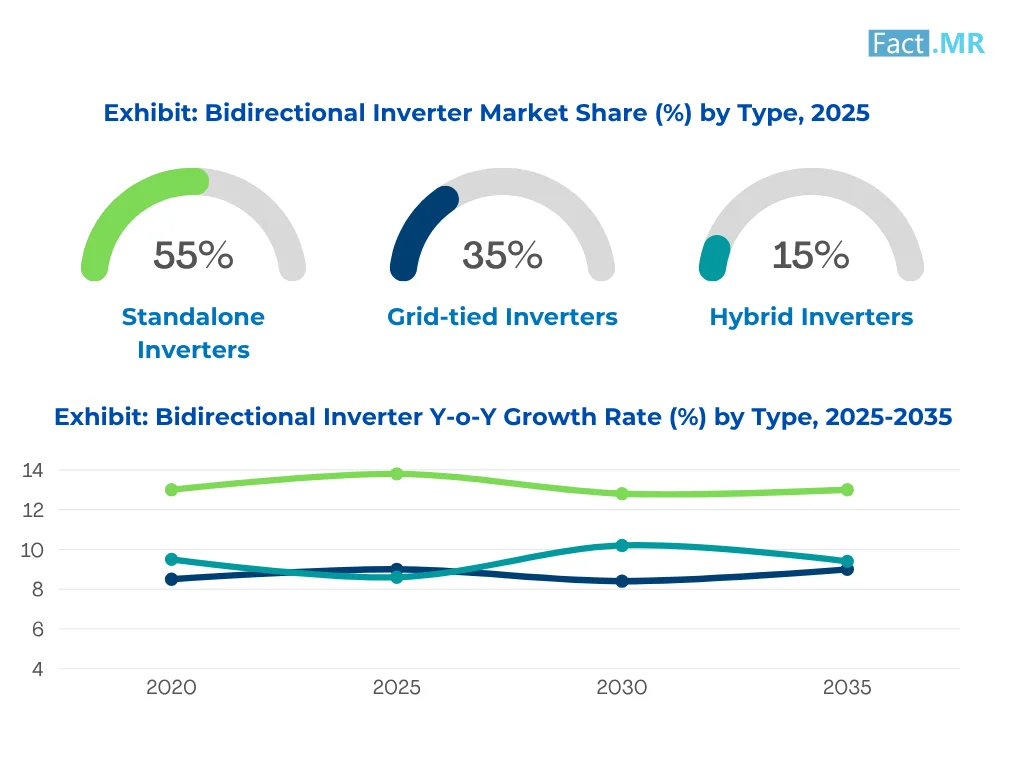Bidirectional Inverter Market
Bidirectional Inverter Market Analysis, By Type (Standalone Inverters, Grid-tied Inverters, and Hybrid Inverters), By Power Rating, By Application (Energy Storage Systems (ESS), Renewable Energy Systems, and Others), By End User (Residential, Commercial, Industrial, and Utility), and Region - Market Insights 2025 to 2035
Analysis of Bidirectional Inverter Market Covering 30+ Countries Including Analysis of US, Canada, UK, Germany, France, Nordics, GCC countries, Japan, Korea and many more.
Bidirectional Inverter Market Outlook (2025 to 2035)
The global bidirectional inverter market is poised for exponential growth, expanding from USD 2,952 million in 2024 to USD 8,452 million by 2035. This translates to a robust CAGR of 10.2% between 2025 and 2035, underscoring sustained momentum across both developed and emerging markets.

Bidirectional inverters have become the core of any modern energy system, enabling the unhindered two-way flow of power between the grid, renewable sources, and energy storage systems. They ensure that energy is optimally utilized in a solar-plus-storage, an electric vehicle, or a microgrid-type application. The importance of bidirectional inverters is increasing rapidly as the world works towards clean energy, decentralized power infrastructure, and integration with the smart grid.
Modern energy ecosystems heavily depend on the evolution of the bidirectional inverter market. Bidirectional inverters make it possible to send or receive power, thereby supporting both storage and contribution to the grid. Integration of these devices is fundamental to supporting electric cars, renewable power grids, and battery-based energy storage.
As the requirements for smart energy solutions grow, bidirectional inverters are increasingly important for maximizing energy efficiency and backing decentralized power networks. The shift toward clean energy infrastructure is driving the growing relevance of bidirectional inverters in residential, commercial, and industrial settings, making them essential for future energy systems.
As a smart grid component, bidirectional inverters provide important capacity for shifting energy flows and ensuring balance during supply shortages. Enhanced interest in energy resilience and self-sufficiency within both domestic and business environments will promote even more adoption. Advancements in inverter design, combined with effective public policies, are anticipated to accelerate market development on a long-term basis.
What factors are driving the growth of the bidirectional inverter market globally and regionally?
Rapid deployment of renewable energy systems, increasing demand for EVs, and expanded use of energy storage solutions act as important drivers for the bidirectional inverter market. Incentives from governments to encourage both green power and grid updates are driving the development of advanced inverter implementations.
Heightened interest in conserving energy and assuring backup power is urging the adoption of intelligent power systems among residential and commercial users. The development of prosumers is driving up demand for inverters that enable two-way energy transmission and storage, establishing these inverters as key to energy independence and smart infrastructure.
What are the key market trends shaping the growth of the bidirectional inverter market?
Developments in the bidirectional inverter market include increased use of hybrid inverters, linkages with AI-based energy management technologies, and remote monitoring and control made possible by the incorporation of IoT. The growing demand for decentralized energy systems is leading to the increased adoption of inverters in both microgrid and residential energy settings.
As electric vehicle adoption increases, both V2G and V2H applications are starting to become more widespread. Designers and manufacturers are increasingly targeting products that are compact, efficient, and capable of handling multiple input sources, such as solar energy and batteries. The market is shifting towards infrastructure that is both flexible and resilient, as evidenced by these trends.
What factors are restraining growth in the bidirectional inverter market?
Although demand is steadily increasing, the bidirectional inverter industry faces several obstacles. Insufficient awareness among residential and commercial customers, as well as the high installation costs, limit adoption, especially in areas where cost is a primary concern.
Deployment may be hindered by the challenges of integrating bidirectional inverters with existing grids and uncertainties regarding system interoperability. Areas with old electrical infrastructure need to invest in major upgrades to introduce two-way power flow. The presence of disparate regulations and standards across multiple areas makes it more challenging for manufacturers to enter the market.
The possibility of cyberattacks on connected energy systems heightens concerns, with key applications being particularly vulnerable. Addressing these barriers will depend on effective collaboration among policy creators, technology developers, and educators of consumers.
Which regions are leading the bidirectional inverter market and what drives their growth?

Utility-scale solar and residential energy storage installations are exploding in California and Texas, making the U.S. a leader in North America for V2G and energy storage integrations. Policymakers' actions to foster distributed generation and modernize the grid are driving rapid developments.
East Asia’s speedy advancement is attributed to the urgent targets for electrification and the modernization of city infrastructure. Pioneering V2H and home storage systems in Japan has established the country as a significant market for hybrid inverters.
There is a persistent demand in Western Europe for bidirectional inverters, mainly due to its ambitious climate strategies, encouragement of solar and storage investments, and rigorous energy efficiency building codes. In Germany, the UK, and the Netherlands, the increasing number of smart grid and microgrid installations is fueling greater adoption of inverters.
Country-wise Outlook
United States bidirectional inverter market accounted for a revenue of USD 607.2 Mn in 2025
Advances in both public safety and smart city infrastructure, together with investments in emergency response infrastructure, will support the growth of the United States Bidirectional Inverter market. The need for exact density measurement devices is expanding, as there is ongoing investment in industrial automation and petrochemical processing and wastewater management programs.
Real-time monitoring, enabled by IoT wireless technology, improves the performance of the Bidirectional Inverter in various industrial applications. Joint operations with established industrial companies enable greater market adoption of major infrastructure projects. Environmental Protection Agency (EPA) and the Food and Drug Administration (FDA) must develop standards that require precise and dependable measurement devices. The U.S. market for bidirectional inverters is growing steadily, driven by differentiated products that comply with regulations and meet industrial needs.
Bidirectional Inverter market in Germany is expanding due to its firm policy on energy transformation and electrification
Bidirectional inverters find wider use in energy storage and EV charging because of the crucial role played by German automotive and industrial automation firms. Technology innovation is primarily driven by companies, with a focus on integrating inverters for smart grids and Vehicle-to-Grid (V2G) use. Adherence to EU Renewable Energy Directives and the drive toward digital energy solutions in Germany work together to accelerate the use of efficient, grid-interactive inverter systems.
The adoption of smart manufacturing methods in Industry 4.0 settings strengthens the market, driven by an increased requirement for real-time energy monitoring and improved power efficiency, especially in eco-friendly regions.
China is expected to register a CAGR of 11.6% over the forecast period

The bidirectional inverter market in China has experienced accelerated growth due to huge government efforts in enhancing manufacturing infrastructure and strengthening petrochemical and energy-efficient capabilities. The 'Made in China 2025' strategy has China giving particular attention to the transfer of Bidirectional Inverter into the industrial IoT device category.
Essential system reliability and product quality in the Chinese oil, gas, and chemistry industries require the immediate installation of state-of-the-art density measuring technologies. Market expansion in the water treatment and pollution control sectors results from the combined efforts of smart city agendas and the development of environmental monitoring systems.
The deployment of functional snacks in China has grown primarily due to the Chinese government's support for technological independence and stringent environmental protection and product quality standards, which has accelerated the growth of the snack market.
Category-Wise Market Outlook
Bidirectional Inverter Market by Type

Hybrid Inverters represent the most rapidly expanding class within the diverse inverter types at present. What primarily drives their growth is their dual-mode functionality, as it enables users to be energy-resilient and self-reliant while still leveraging the grid’s advantages.
As they link with solar arrays, battery systems, and intelligent energy control, they excel in adaptable, distributed energy systems. The growing popularity of residential solar installations and the need for reliable energy in areas vulnerable to natural disasters also increases demand for hybrid inverters.
Bidirectional Inverter Market by Power Rating
The top growth rate in power ratings belongs to the sub-segment ranging from 10 kW to 50 kW. The range is optimally suited for serving small businesses and much larger residential systems. The trend of decentralized energy sources, evident notably in commercial facilities, smaller manufacturing sites, and apartment communities, is driving up the adoption of medium-sized inverters.
Because these systems combine economic advantages with a high output, they are becoming the preferred choice for optimizing energy in rapidly expanding urban and peri-urban regions.
Bidirectional Inverter Market by Application
The group of EVs and V2G applications is now considered the most vibrant and rapidly developing sub-segment in the market. The widespread adoption of electric vehicles on a global scale, combined with ongoing advancements in Vehicle-to-Grid (V2G) technologies, is driving increased demand for inverters that enable cars to both receive and provide electricity to either a grid or a building system.
Because bidirectional inverters offer both grid support and energy cost savings, they are highly valued in zones working to reach ambitious EV and smart grid goals.
Bidirectional Inverter Market by End Use
Among the end-use segments, commercial is experiencing the most rapid growth. Investments by businesses in renewable energy systems, energy storage, and energy management are increasing, aiming to reduce their operational expenses while also enhancing sustainability.
These inverters help commercial establishments utilize energy more efficiently by matching on-site renewable sources and storage technology. The commercial sector’s sensitivity to regulatory drivers and ESG goals significantly accelerates the adoption of flexible energy technologies, such as bidirectional inverters.
Competitive Analysis
Competitive Outlook Report: Bidirectional Inverter Market
The bidirectional inverter market is going through a period of major change driven by the fast growth of renewable energy integration and the rising demand for energy storage solutions. Significant manufacturers are relying on technical advances in power electronics, digital surveillance, and system compatibility to improve device performance and dependability. Major firms, such as Huawei, Sungrow, and Schneider Electric, dominate the market with a wide range of products tailored to various usage sectors.
Businesses are working to increase market rivalry through research and development initiatives, partnerships, and geographic expansion. Differentiating in the market is increasingly centered on sustainability, grid robustness, and modular product development. New companies and startups are entering the market, introducing increased activity, especially in less developed regions. Overall, the sector’s competitive environment exhibits a significant focus on decentralization, off-grid solutions, and digital technologies, which are poised to foster ongoing innovation and international growth.
Key players of the bidirectional inverter industry are Huawei Technologies Co., Ltd., Sungrow Power Supply Co., Ltd., Fronius International GmbH, SolarEdge Technologies Inc., Enphase Energy Inc., SMA Solar Technology AG, GoodWe, Growatt New Energy Technology Co., Ltd., Delta Electronics, Deming Power, and Schneider Electric.
Recent Development
- In September 2024, at RE+ 2024, Fronius International GmbH unveiled an upgraded version of its GEN24 residential hybrid inverter. The new model features improved energy management capabilities, increased system efficiency, and enhanced integration with solar and battery storage systems, supporting homeowners with smarter, more resilient energy solutions tailored for modern living.
- In September 2024, Growatt New Energy Technology Co., Ltd. introduced its latest line of inverters designed for residential off-grid PV systems. These new models offer enhanced efficiency, reliability, and energy storage capacity, catering to remote and independent power users seeking high-performance solutions for sustainable, self-sufficient energy generation and storage.
Fact.MR has provided detailed information about the price points of key manufacturers in the bidirectional inverter market, positioned across regions, including sales growth, production capacity, and speculative technological expansion, in the recently published report.
Methodology and Industry Tracking Approach
The global bidirectional inverter market study 2025 interviewed 10,800 stakeholders in 30 countries and more than 300 stakeholders in a specific region. Two-thirds of the respondents were end users and OEMs (including microgrid developers, EV charging providers, and industrial engineers). In contrast, a third of them consisted of professionals (including utility planners and policy regulators).
The period of data collection spanned from June 2024 to May 2025, covering the deployment trend, technological progress, and investment patterns. The answers were adjusted to reflect regional market shares and the intensity of electrification.
More than 280 secondary sources (patents, compliance filings, and financial reports) were used to validate. Fine-grained regressive analysis, scenario analysis, and opportunity mapping were employed to assess pricing elasticity, policy threats, and demand gaps. This provided us with a precise and real-life understanding of supply chains, application development, and future inverter strategies worldwide.
With Fact.MR monitoring consumer behavior, product efficacy, industry trends, and market opportunities since 2018, this report is becoming an authoritative source of information that stakeholders can rely on.
Segmentation of Bidirectional Inverter Market Research
-
By Type :
- Standalone Inverters
- Grid-tied Inverters
- Hybrid Inverters
-
By Power Rating :
- Less than 10 kW
- 10 kW to 50 kW
- Above 50 kW
-
By Application :
- Energy Storage Systems (ESS)
- Renewable Energy Systems
- Electric Vehicles (EVs) and Vehicle-to-Grid (V2G)
- Uninterruptible Power Supply (UPS)
-
By End Use :
- Residential
- Commercial
- Industrial
- Utility
-
By Region :
- North America
- Latin America
- Western Europe
- Eastern Europe
- East Asia
- South Asia & Pacific
- Middle East & Africa
Table of Content
- Executive Summary
- Industry Introduction, including Taxonomy and Market Definition
- Trends and Success Factors
- Market Dynamics
- Recent Industry Developments
- Global Market Demand Analysis 2020 to 2024 and Forecast 2025 to 2035
- Pricing Analysis
- Global Market Analysis 2020 to 2024 and Forecast 2025 to 2035
- Type
- Power Rating
- Application
- End Use
- By Type
- Standalone Inverters
- Grid-tied Inverters
- Hybrid Inverters
- By Power Rating
- Less than 10 kW
- 10 kW to 50 kW
- Above 50 kW
- By Application
- Energy Storage Systems (ESS)
- Renewable Energy Systems
- Electric Vehicles (EVs) and Vehicle-to-Grid (V2G)
- Uninterruptible Power Supply (UPS)
- By End Use
- Residential
- Commercial
- Industrial
- Utility
- By Region
- North America
- Latin America
- Western Europe
- Eastern Europe
- East Asia
- South Asia Pacific
- Middle East & Africa
- North America Sales Analysis 2020 to 2024 and Forecast 2025 to 2035, by Key Segments and Countries
- Latin America Sales Analysis 2020 to 2024 and Forecast 2025 to 2035, by Key Segments and Countries
- Western Europe Sales Analysis 2020 to 2024 and Forecast 2025 to 2035, by Key Segments and Countries
- Eastern Europe Sales Analysis 2020 to 2024 and Forecast 2025 to 2035, by Key Segments and Countries
- East Asia Sales Analysis 2020 to 2024 and Forecast 2025 to 2035, by Key Segments and Countries
- South Asia Pacific Sales Analysis 2020 to 2024 and Forecast 2025 to 2035, by Key Segments and Countries
- Middle East & Africa Sales Analysis 2020 to 2024 and Forecast 2025 to 2035, by Key Segments and Countries
- Sales Forecast to 2035 by Type, Power Rating, Application, and End Use for 30 Countries
- Competitive Assessment
- Company Share Analysis by Key Players
- Competition Dashboard
- Company Profile
- Huawei Technologies Co., Ltd.
- Sungrow Power Supply Co., Ltd.
- Fronius International GmbH
- SolarEdge Technologies Inc.
- Enphase Energy Inc.
- SMA Solar Technology AG
- GoodWe
- Growatt New Energy Technology Co., Ltd.
- Delta Electronics
- Deming Power
- FAQs -
What was the Global Bidirectional Inverter Market Size Reported by Fact.MR for 2024?
The global Bidirectional Inverter Market was valued at USD 2,952 Million in 2024.
Who are the Major Players Operating in the Bidirectional Inverter Market?
Prominent players in the market are Huawei Technologies Co., Ltd., Sungrow Power, Growatt New Energy Technology Co., Ltd., Delta Electronics, Deming Power, and Schneider Electric.
What is the Estimated Valuation of the Bidirectional Inverter Market in 2035?
The market is expected to reach a valuation of USD 8,452 Million in 2035.
What Value CAGR did the Bidirectional Inverter Market Exhibit over the Last Five Years?
The historic growth rate of the Bidirectional Inverter Market was 8.4% from 2020 to 2024.